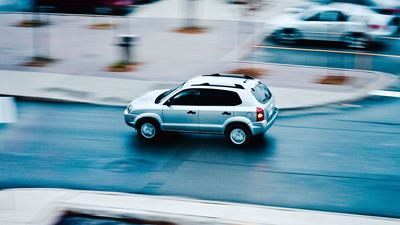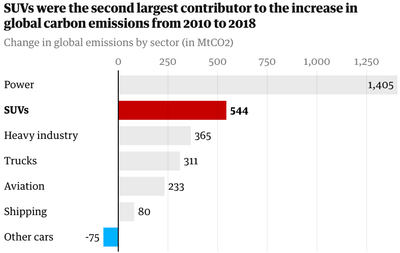Credit: Justin S. Campbell/Flickr
Growing demand for SUVs was the second largest contributor to the increase in global CO2 emissions from 2010 to 2018, an analysis has found. In that period, SUVs doubled their global market share from 17 percent to 39 percent and their annual emissions rose to more than 700 megatons of CO2, more than the yearly total emissions of the UK and the Netherlands combined.
No energy sector except power drove a larger increase in carbon emissions, putting SUVs ahead of heavy industry (including iron, steel, cement and aluminum), aviation, and shipping. “We were quite surprised by this result ourselves,” said Laura Cozzi, the chief energy modeler of the International Energy Agency, which produced the report.
The recent dramatic shift towards heavier SUVs has offset both efficiency improvements in smaller cars and carbon savings from electric vehicles. As the global fleet of SUVs has grown, emissions from the vehicles have increased more than four-fold in eight years. If SUV drivers were a nation, they would rank seventh in the world for carbon emissions.
“An SUV is bigger, it’s heavier, the aerodynamics are poor, so as a result you get more CO2,” said Florent Grelier from the campaign group Transport & Environment.
T&E figures show the average mass of new cars rose 10 percent between 2000 and 2016, which the group suggested could be down to a trend towards SUVs, heavier automatic and dual-clutch gearboxes, and the inclusion of other equipment including cameras and sensors.
Grelier said the global shift towards bigger cars had been observed for a while, but the effect on emissions increases compared with other industries was surprising nonetheless.
“The problem is much bigger than we expected,” he said.
The global car market has been stalling in recent years, which analysts have attributed to the escalating China–U.S. trade war and the sluggish performance of the Chinese economy in general.
The SUV segment has so far bucked this trend, however, with a record 35 million vehicles sold in 2018. The IEA figures show that SUVs steadily increased their share across major markets all around the world, from Europe and the U.S. to China and India.
Cozzi said this was another surprise: “We thought this was a trend that was more concentrated in a few countries … but it’s becoming really universal.”
In the U.S., nearly one in two passenger cars sold today is an SUV.
The IEA’s definition of “SUV” covers a range of cars from crossovers to off-road vehicles. Popular models in the UK include the Nissan Qashqai, Hyundai Tucson and Land Rover Range Rover.
The emissions analysis considered only the carbon produced from fuel combustion, not any emissions embedded in the manufacturing of the cars – where larger models are also likely to result in more emissions.
SUVs started to become popular in the 1980s, and often earned nicknames such as “Chelsea tractor” as a result of the wealthy city suburbs they became associated with. Since then, sales have continued to rise, and the vehicles are often marketed as a status symbol.
However, opposition to SUVs in cities is also rising. Recent protests in Berlin demanded a ban on the vehicles after a driver hit and killed four pedestrians, while activists at a Frankfurt motor show protested against the vehicles’ impact on the climate. SUVs are significantly more likely to kill pedestrians in crashes, and although they are often marketed as safer, those driving them are 11 percent more likely to die in a crash than people in normal cars.
Cozzi said a number of factors were driving the demand for bigger cars. While perceptions of heightened safety or increased social status could play a role at the individual level, she also pointed towards manufacturers’ changing offering.
She said the difficult market situation led carmakers to look for the most profitable models in their ranges. “There is a really big need for car manufacturers to find the margins wherever it is possible, and the SUV segment seems to be one of those places,” she said.
In the UK, the transport sector overtook energy generation as the number one source of greenhouse gas emissions in 2016. According to a Guardian analysis of Department for Transport statistics, there are about 5 million licensed SUVs in the UK today. The UK government has pledged to ban the sale of new petrol and diesel cars from 2040, although hybrid models would be exempt under the plan. The Committee on Climate Change, the government’s independent adviser, says the ban should be brought forward to 2035 and include hybrid cars.
Across the EU, electric vehicles made up only 2 percent of new cars sold last year, but a recent report from Transport & Environment suggests that figure could reach 10 percent by 2021.
This is due in part to EU emissions targets, phased in from next year, which will put much stricter limits on the average emissions of each manufacturer’s newly registered cars.
Experts are stressing that quick decarbonization of the transport sector will also require a reduction in the total number of passenger cars on the road, particularly in big cities.
“We need to keep less and less space for cars so that it’s more convenient for people to use other means of transportation, whether it’s walking, cycling or public transport,” Grelier said.
—Niko Kommenda, The Guardian




